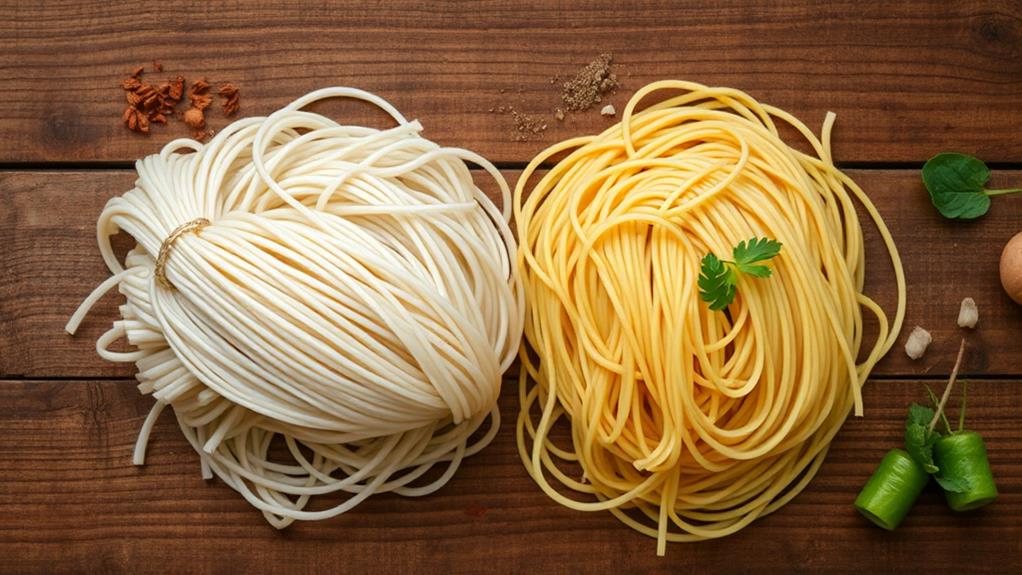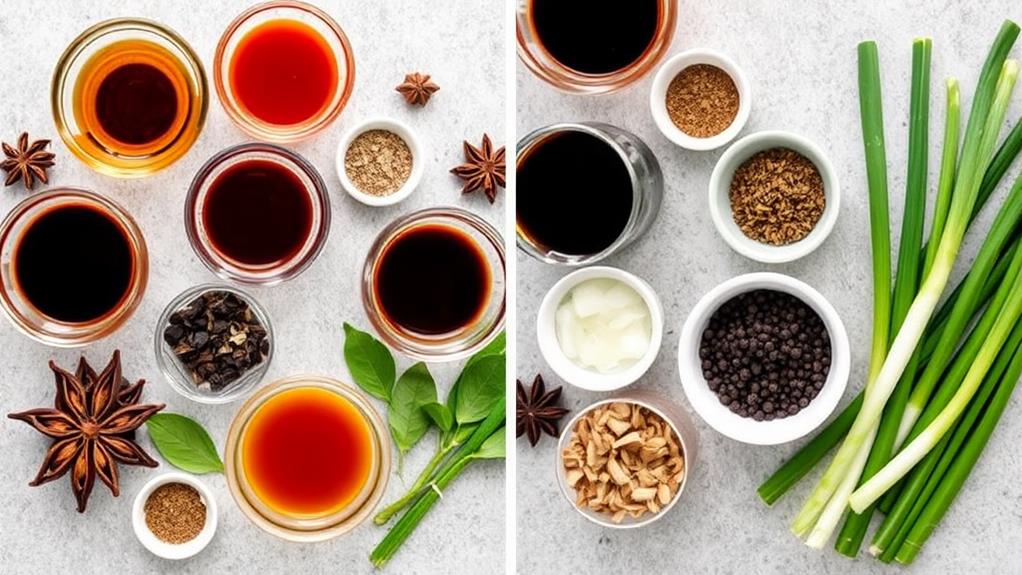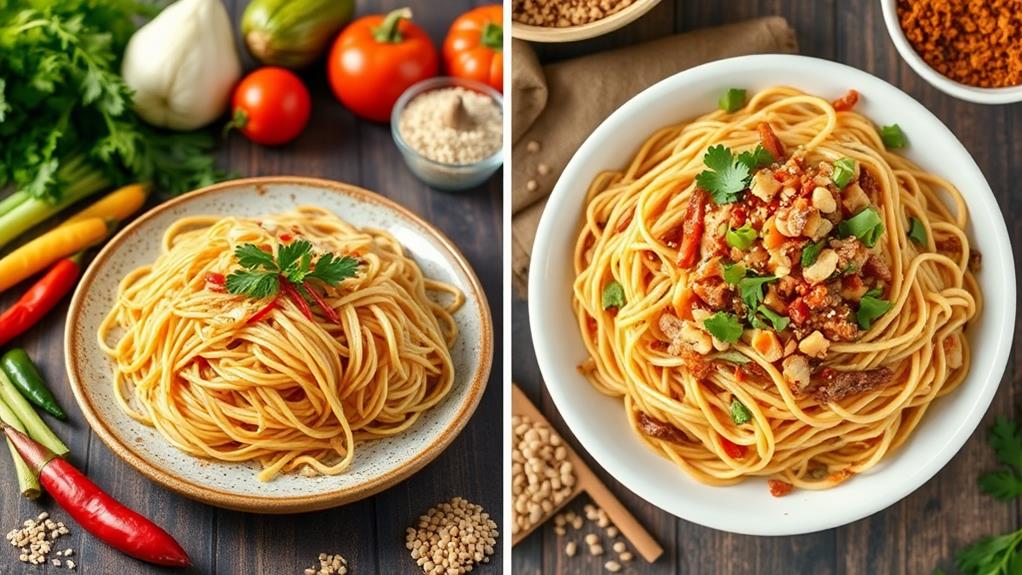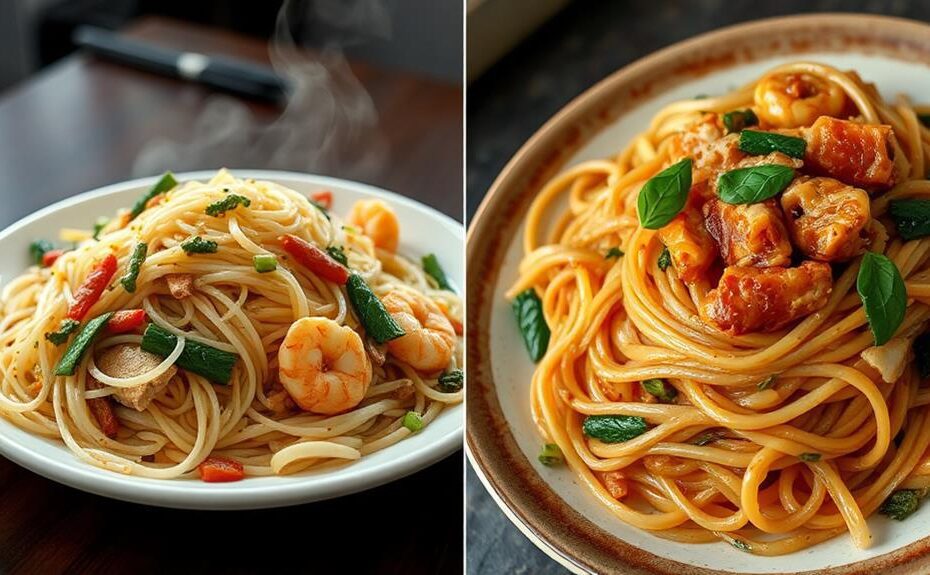Pancit Bihon and Pancit Canton differ in their noodle types and textures.
Pancit Bihon features thin, glass-like rice noodles with a delicate mouthfeel, while Pancit Canton boasts thicker, chewier egg noodles.
Proteins are a common ingredient in both dishes.
They often include chicken, shrimp, and pork.
Vegetables like cabbage and carrots are also commonly used in both Pancit Bihon and Pancit Canton.
Soy sauce, garlic, and onions add depth to both dishes.
Oyster sauce and fish sauce are often used in Pancit Canton to give it a distinct flavor.
Noodle Types and Textures

Noodle Types and Textures in Pancit Bihon and Pancit Canton
Pancit Bihon and Pancit Canton noodles differ significantly in terms of type and texture. Pancit Canton noodles are thicker, long egg noodles made from wheat flour, providing a chewier texture.
In contrast, Pancit Bihon noodles are thinner, glass-like noodles made from rice, offering a lighter and more delicate mouthfeel.
The combination of both noodle types in dishes like Pancit Canton at Bihon creates a more interesting texture. Canton noodles are suitable for stir-fry dishes like Lo Mein, while bihon noodles are staples in various Filipino recipes, showcasing their versatility.
When cooking, it's essential to adjust methods according to the noodle type. Bihon noodles require soaking in water to soften, whereas Canton noodles can be stir-fried directly after boiling.
Understanding these differences enables the creation of a more authentic and balanced Filipino dish. By choosing the right noodle type, you can elevate your Pancit Bihon and Pancit Canton recipes.
Protein and Vegetable Options
Protein Options Enhance Flavor and Nutrition
Two essential protein options in Pancit Bihon are shredded chicken and shrimp, which offer diverse flavors and textures.
In Pancit Canton, common protein options include chicken strips, pork, and occasionally beef or seafood, which can be marinated for enhanced taste.
Vegetable Options Add Nutrition and Color
Cabbage, carrots, bell peppers, green beans, and celery are frequently used vegetables in both dishes, contributing to their nutritional value and color.
The use of shrimp in Pancit Bihon adds a seafood flavor and provides additional protein, complementing the other ingredients.
Customization for Dietary Needs
Both dishes can be customized with additional proteins and vegetables based on personal preferences, making them versatile for various dietary needs.
This flexibility allows experimentation with different protein and vegetable combinations to suit individual tastes.
Flavor Enhancers and Seasonings

Flavor Enhancers and Seasonings in Pancit Bihon and Pancit Canton
The combination of flavor enhancers and seasonings is crucial in bringing out the complex flavors of Pancit Bihon and Pancit Canton. Soy sauce is a key flavor enhancer in both dishes, providing a savory umami taste that complements the proteins and vegetables. In Pancit Canton, oyster sauce is often added to enhance the richness and depth of the dish.
| Flavor Enhancer | Description | Dish(es) |
|---|---|---|
| Soy Sauce | Savory umami taste | Both |
| Oyster Sauce | Richness and depth | Canton |
| Garlic and Onions | Aromatic flavors | Both |
| Lemon/Calamansi Juice | Zesty brightness | Both |
When cooking Pancit Bihon and Pancit Canton, sautéing freshly minced garlic and chopped onions at the beginning infuses the oil with aromatic flavors that form the base of the dish. Fish sauce can be added to contribute a distinct saltiness and depth without overpowering the other ingredients. Finally, a squeeze of lemon or calamansi juice on the side allows diners to add a burst of freshness to their noodles.
Cooking Methods and Techniques
Cooking Pancit Bihon and Pancit Canton: Key Techniques
The art of cooking these two popular Filipino noodle dishes lies in their distinct cooking methods and techniques.
Preparation of Noodles
When cooking Pancit Bihon, soak rice vermicelli noodles in warm water for about 10 minutes until they're softened.
In contrast, Pancit Canton uses egg noodles that can be boiled or stir-fried directly without soaking.
Building Flavor
To create a flavorful base, sauté garlic and onions in oil, then add proteins like chicken, shrimp, or pork, cooking them until fully done.
Next, add vegetables, briefly sautéing them to maintain their crispness and vibrant color.
Cooking Techniques
Pancit Bihon:
* Soak noodles before combining them with the sautéed mixture and seasonings.
Pancit Canton:
- Add noodles directly to the pan with the rest of the ingredients, using less liquid due to their quick cooking time.
- Stir-fry everything together, allowing the noodles to absorb the flavors and ensuring the ingredients are well combined.
Nutritional Value and Benefits

Pancit Bihon and Pancit Canton offer a wealth of nutritional benefits, making them a great addition to a balanced diet.
Protein from chicken, pork, and shrimp contributes to muscle health and repair. This is because protein is essential for building and repairing muscles, making it a crucial component of a healthy diet.
Vegetables like carrots, cabbage, and bell peppers provide essential vitamins and minerals, promoting overall health and immune function. These vegetables are rich in vitamins A, C, and K, as well as minerals like potassium and fiber, which are vital for maintaining overall health.
Bihon (rice noodles) and canton (egg noodles) are rich in carbohydrates, providing a vital energy source for the body. This is particularly important for individuals with an active lifestyle, as carbohydrates are the body's primary source of energy.
However, it's essential to consume soy sauce in moderation due to its high sodium content, which can negatively impact heart health. Excessive sodium consumption can lead to high blood pressure, heart disease, and stroke.
To reap the nutritional benefits of Pancit Bihon and Pancit Canton, it's crucial to balance them with appropriate portion sizes and combine them with additional servings of vegetables. This ensures that the dish is part of a well-rounded and healthy diet.
What Are the Key Ingredients in Pancit Bihon and Pancit Canton?
Pancit Bihon and Pancit Canton are both popular Filipino noodle dishes. The key ingredients in Pancit Bihon include rice noodles, chicken, shrimp, and various vegetables. On the other hand, Pancit Canton typically includes egg noodles, pork, cabbage, and carrots. The main difference between pancit bihon and pancit canton lies in the type of noodles used.
Cultural Significance and Variations
Pancit Bihon and Pancit Canton are staples in Filipino celebrations, symbolizing sharing, unity, and prosperity. These noodles are often served at birthdays, holidays, and family gatherings, highlighting their cultural significance.
Filipino culture is diverse, and Pancit Bihon and Pancit Canton reflect this diversity through regional variations. Pancit Bihon's rice noodles showcase Chinese influence, while Pancit Canton's egg noodles demonstrate Western adaptation. These variations are a result of historical trade and colonization, making the dishes a cultural melting pot.
Pancit dishes can be personalized with various proteins, such as chicken, pork, and shrimp, and vegetables, allowing for flexibility based on dietary preferences and available ingredients.
The communal eating aspect of Pancit fosters a sense of togetherness among family and friends, making it a beloved part of Filipino cuisine.
Regional variations of Pancit Bihon and Pancit Canton have unique flavor profiles and cultural significance, highlighting the adaptability of these dishes.
Frequently Asked Questions
What Is the Difference Between Pancit Bihon and Pancit Canton?
The main difference between pancit bihon and pancit canton lies in their noodle types.
Pancit bihon uses thin rice vermicelli, while pancit canton utilizes thicker egg noodles.
This distinction affects cooking techniques as well.
Bihon noodles are soaked before stir-frying, whereas canton noodles are boiled.
These variations result in distinct textures and flavors, catering to diverse tastes.
What Does Pancit Canton Contain?
Pancit Canton is a highly customizable dish. It can be made with different types of noodles, including rice noodles or thicker egg noodles.
You can add various toppings, such as vegetables, proteins, and even eggs, to create your desired combination.
Cooking techniques also vary, with some recipes involving quick stir-fries and others requiring longer simmering times.
Regardless of the variation, Pancit Canton is known for its savory flavors and textures.
What Is Pancit Bihon Made Of?
Pancit bihon is a traditional Filipino dish composed of rice vermicelli noodles as its base. These noodles are softened in warm water before cooking.
The dish typically includes a mix of proteins such as shredded chicken, shrimp, and sometimes pork. Additionally, sautéed garlic and onion are added for flavor.
The dish also features a variety of colorful vegetables like carrots and cabbage.
What Are the Ingredients in Pancit Canton Seasoning?
Pancit Canton seasoning typically consists of a blend of soy sauce, oyster sauce, garlic, and onion. These ingredients are sautéed to bring out their aromas, creating a rich, savory base flavor.
Regional variations may include additional ingredients, but these staples provide the core flavor profile.
To adjust the seasoning to your taste, you can balance the flavors with salt, pepper, and possibly chicken broth. This combination creates a complex flavor profile that elevates your Pancit Canton dish.
